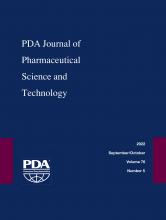Abstract
In response to regulatory citations for not including plant isolates in method suitability and growth promotion testing of microbiological culture media, the authors make the case that the compendial designated cultures meet the requirements of the official tests and are sufficiently representative of the most frequently identified environmental isolates. It was our conclusion that this compliance request lacks scientific justification. The scope of this review was largely directed to the growth promotion and suitability testing requirements for USP <60>, <61>, <62>, and <71>. Other microbiological tests such as USP <51> Antimicrobial Effective Testing, media fill validation, and water and environmental monitoring are discussed.
- Plant isolates
- Compendial designated cultures
- Method suitability
- Growth promotion
- Microbial tests
- 483 observations
- Warning letters
- © PDA, Inc. 2022
PDA members receive access to all articles published in the current year and previous volume year. Institutional subscribers received access to all content. Log in below to receive access to this article if you are either of these.
If you are neither or you are a PDA member trying to access an article outside of your membership license, then you must purchase access to this article (below). If you do not have a username or password for JPST, you will be required to create an account prior to purchasing.
Full issue PDFs are for PDA members only.
Note to pda.org users
The PDA and PDA bookstore websites (www.pda.org and www.pda.org/bookstore) are separate websites from the PDA JPST website. When you first join PDA, your initial UserID and Password are sent to HighWirePress to create your PDA JPST account. Subsequent UserrID and Password changes required at the PDA websites will not pass on to PDA JPST and vice versa. If you forget your PDA JPST UserID and/or Password, you can request help to retrieve UserID and reset Password below.






